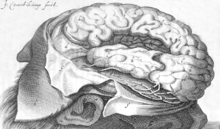Franciscus Sylvius
Franciscus Sylvius | |
|---|---|
M.D., 1637) | |
| Known for | Sylvian fissure Aqueduct of Sylvius |
| Scientific career | |
| Institutions | Leiden University |
| Theses |
|
Ehrenfried von Tschirnhaus | |
Franciscus Sylvius (Dutch:
Life
Sylvius, a
He studied medicine at the
On 16 March 1637 he defended a
Work
In 1669 Sylvius founded the first academic chemical laboratory.[
He founded the Iatrochemical School of Medicine, according to which all life and disease processes are based on chemical actions. That school of thought attempted to understand medicine in terms of universal rules of physics and chemistry. Sylvius also introduced the concept of chemical affinity as a way to understand the way the human body uses salts and contributed greatly to the understanding of digestion and of bodily fluids. The most important work he published was Praxeos medicae idea nova (New Idea in Medical Practice, 1671). Specifically, he explained that digestion is a result of the chemical reactions of acids and bases coming from pancreatic, stomach, and saliva secretions.[6]

He researched the structure of the brain and was credited as the discoverer of the cleft in the brain known as Sylvian fissure by Caspar Bartholin in his 1641 book Casp. Bartolini Institutiones Anatomicae[7] In this book, it is noted that in the preface that "We can all measure the nobility of Sylvius’s brain and talent by the marvelous, new structure of the brain". And also, "In the new images of the brain, the engraver followed the design and scalpel of the most thorough Franciscus Sylvius, to whom we owe, in this part, everything that the brain has the most, or the most wonderful of".[7]
However Caspar Bartholin died in 1629 and Franciscus Sylvius only started medicine in 1632 and it has been argued that the words in this word describing the Sylvian fissure are either by his son Thomas Bartholin or indeed Franciscus Sylvius.[7] In 1663 in his Disputationem Medicarum, Franciscus Sylvius under his own name described the lateral fissure: "Particularly noticeable is the deep fissure or hiatus which begins at the roots of the eyes (oculorum radices) [...] it runs posteriorly above the temples as far as the roots of the brain stem (medulla radices). [...] It divides the cerebrum into an upper, larger part and a lower, smaller part".[7]
The
The mineral sylvite was also named for Sylvius.[8]
His book Opera Medica, published posthumously in 1679, recognizes
He owned a collection of 190 paintings, nine by
References
- ^ Burchard de Volder (1664). "De Natura" (PDF).
- ^ Gin, tasteoftx.com, archived from the original on 16 April 2009, retrieved 5 April 2009
- ^ Origins of Gin, Bluecoat American Dry Gin, archived from the original on 13 February 2009, retrieved 5 April 2009
- OCLC 14166162.
- ^ OCLC 42969585.
- ISBN 978-0-521-73256-7.
- ^ S2CID 207140931.
- ^ Webmineral, retrieved 2011-10-05.
- ^ Eric J. Sluijter, Marlies Enklaar, Paul Nieuwenhuizen (1988), Leidse fijnschilders: van Gerrit Dou tot Frans Mieris de Jonge, 1630-1760.
